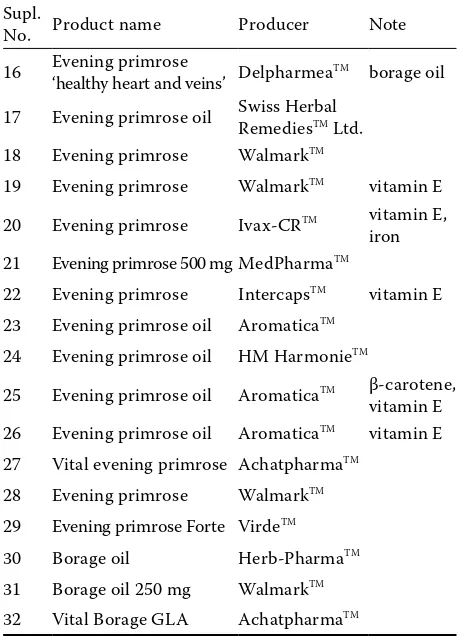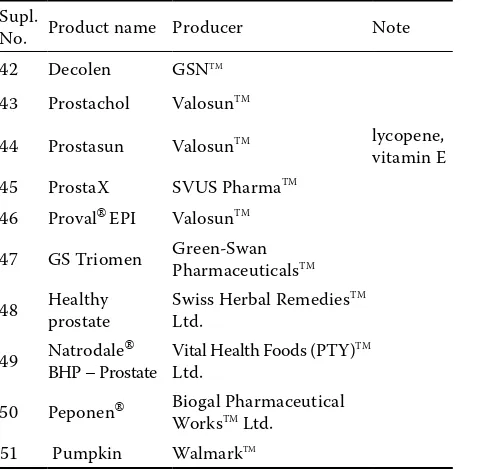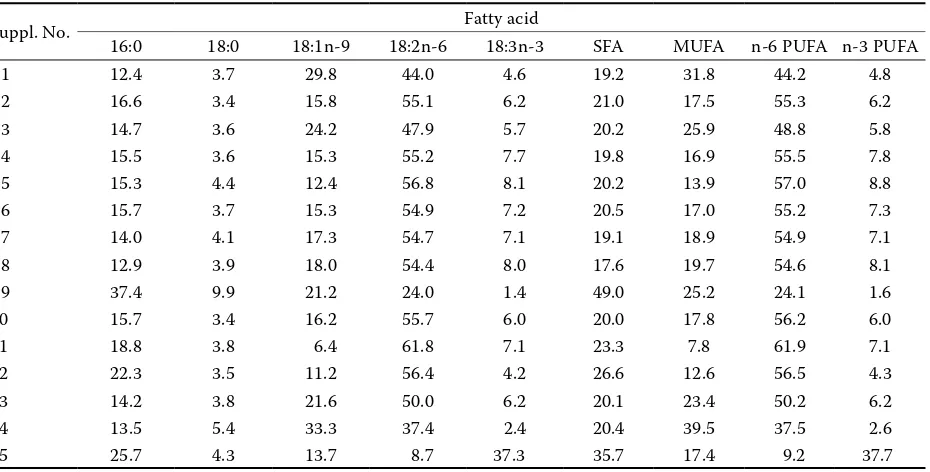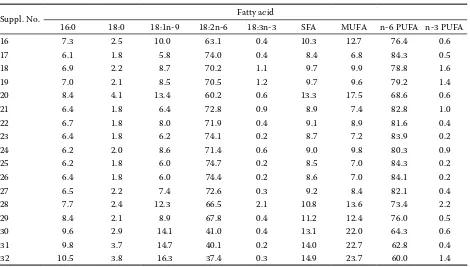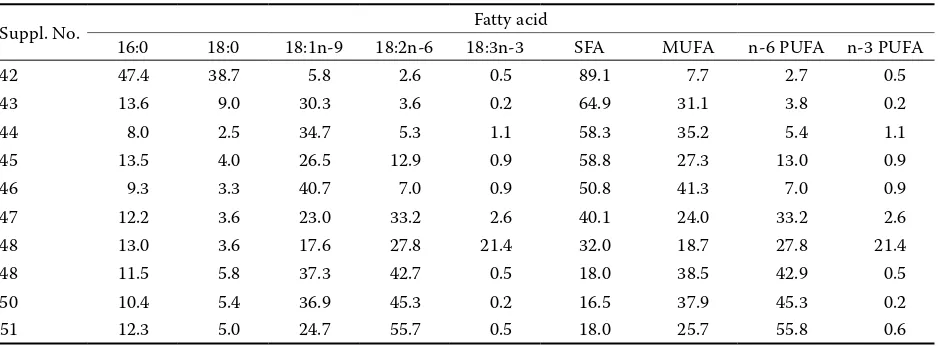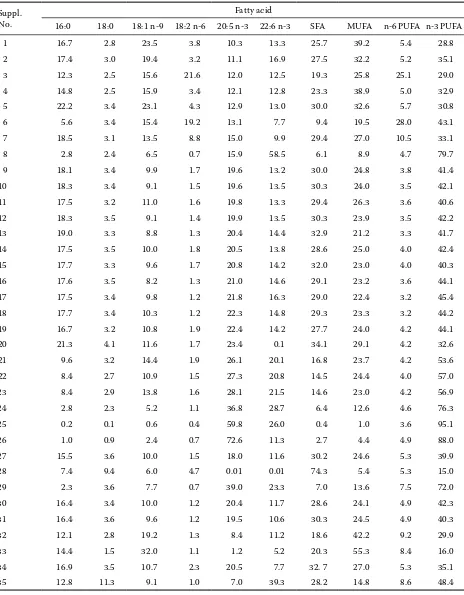Fatty Acid Composition of Commercially Available
Nutrition Supplements
Barbora Staňková, Lefkothea-Stella kremmyda, eva tvrzická and aleš Žák
4
thdepartment of medicine – department of Gastroenterology and Hepatology,
1
stFaculty of medicine, charles University in Prague, Prague, czech republic
Abstract
Staňková B., Kremmyda L.S., Tvrzická E., Žák A. (2013):
Fatty acid composition of commercially
available nutrition supplements
.
Czech J. Food Sci.,
31
: 241–248.
We analysed the fatty acid (FA) composition of plant and fish oil supplements available in the Czech Republic. Total lipid FA composition was analysed by gas chromatography. A total of 62 plant and 50 fish oil supplements were analysed. Their FA composition ranged widely. Linoleic acid was a dominant FA in soya lecithin (45–60%), evening primrose (65–75%), amaranth (20–50%), pumpkin seed (45–55%), and borage oil supplements (40%). α-Linolenic acid ranged between 2% and 8% in soya lecithin and from 0.2% to 1% in the majority of the other plant oil supplements. Saw palmetto oil supple-ments were rich in saturated FA (40–90%). γ-Linolenic acid was found in evening primrose and borage oil supplesupple-ments (10–20%). Sea buckthorn oil composition varied according to the part of the plant used. The majority of fish oil supple-ments contained 12–23% of eicosapentaenoic and 7–17% of docosahexaenoic acids. Oil supplesupple-ments may be beneficial for patients with metabolic disorders because of their FA as well as antioxidant and phytosterol content.
Keywords: dietary fat; plant oil; fish oil
Supported by the Charles University Research Project PRVOUK-P25/LF1/2.
The type of dietary fat ingested is determined by
the fatty acid (FA) composition of foods and
nutri-tion supplements (if consumed) and can
substan-tially influence the human health. It is nowadays
considered that the composition of dietary fat is
very important in determining health outcomes
of metabolic disorders (Kremmyda
et al.
2011;
Tvrzicka
et al.
2011). Dietary FA influence their
composition in plasma lipoproteins, cell
mem-branes, as well as in adipose tissue (Pedersen
et
al.
2011). This tissue has a plethora of endocrine
and autocrine/paracrine functions associated with
the secretion of adipokines (Virtue & Vidal-Puig
2010) and inflammatory mediators (Browning
et
al.
2008). Composition of FA in cell membranes
may in turn affect gene expression and metabolism
(Flachs
et al
. 2009).
Polyunsaturated FA (PUFA) include the n-6 and
n-3 PUFA families. In the n-6 PUFA family the parent
FA is linoleic acid (LA). Its metabolic products are
g
-linolenic (GLA), dihomo-
g
-linolenic (DHGLA),
and arachidonic (AA) acids. High concentrations of
n-6 PUFA are found in soybean oil, sunflower seed
oil, safflower oil, evening primrose oil, and borage
seed oil. As ligands of peroxisome
proliferator-activated receptor-
g
(PPAR-
g
), n-6 PUFA increase
insulin sensitivity, and change the distribution of
fat and the size of adipocytes (Staels 2000).
Im-portantly, AA is a major precursor of eicosanoids
which are potent signalling molecules both inside
and outside the cell (Vergroesen 1989).
Table 1. Soya lecithin containing supplements
Supl.
No. Product name Producer 1 Bio Pharma® Lecithin Bio-Pharma®
2 GS Lecithin 1200 Green-Swan PharmaceuticalsTM
3 Lecithin VitaHarmonyTM
4 Lecithin 1200 mg WalmarkTM
5 Lecithin 1200 mg AlierTM
6 Lecithin Brain PharmaTM
7 Lecithin IntercapsTM
8 Lecithin 1200 mg MedPharmaTM
9 Lecithin Fit SilvitaTM
10 Lecithin Forte LiftecTM
11 Lecithin Natural MagadorTM
12 Soya Lecithin granulate SunpharmTM
13 Super Lecithin 1250 mg Unios Pharma
14 Soyafemin capsules Dr. Theiss NaturwarenGmbH TM
15 Sarapis Soya SanamedTM GmbH
Table 2. Evening primrose and borage oil containing supplements
Supl.
No. Product name Producer Note 16 Evening primrose ‘healthy heart and veins’ DelpharmeaTM borage oil
17 Evening primrose oil Swiss Herbal RemediesTM Ltd.
18 Evening primrose WalmarkTM
19 Evening primrose WalmarkTM vitamin E
20 Evening primrose Ivax-CRTM vitamin E,
iron 21 Evening primrose 500 mg MedPharmaTM
22 Evening primrose IntercapsTM vitamin E
23 Evening primrose oil AromaticaTM
24 Evening primrose oil HM HarmonieTM
25 Evening primrose oil AromaticaTM β-carotene,
vitamin E 26 Evening primrose oil AromaticaTM vitamin E
27 Vital evening primrose AchatpharmaTM
28 Evening primrose WalmarkTM
29 Evening primrose Forte VirdeTM
30 Borage oil Herb-PharmaTM
31 Borage oil 250 mg WalmarkTM
32 Vital Borage GLA AchatpharmaTM
In humans, LA and ALA cannot be synthesised
endogenously and must be taken from the diet
(essential fatty acids; EFA). Further elongation
and desaturation of EFA to produce long-chain
(LC) PUFA (EPA, DHA, AA) is possible but not
very efficient in humans. Long-chain n-3 PUFA
are thought to activate PPAR-α, decrease
lipo-genesis and very low density lipoprotein (VLDL)
secretion (Burdge 2009). The immunomodulatory
properties of LC n-3 PUFA are related to altered
T-lymphocyte activity (Calder 2009) and
eicosa-noid and docosaeicosa-noid production (Serhan 2011).
In persons with metabolic disorders, FA intake may
be inappropriate, characterised by high saturated
FA (SFA) and low monounsaturated FA (MUFA)
and PUFA intake, especially those of the n-3 PUFA
family. Similar changes in plasma FA profiles were
found in such diametrically different metabolic
disorders as metabolic syndrome (characterised by
hypernutrition) on the one side, and different types
of malnutrition (marantic type, kwashiorkor-type,
cancer cachexia) on the other one. These changes
were characterised by significantly decreased
con-tent of LA and increased concon-tent of palmitoleic acid
(Žák
et al
. 2005, 2007) as well as lower content of
plasma n-3 PUFA in cancer patients. Inadequate
or inappropriate FA intake may be compensated by
nutrition supplements. Furthermore, recent trials
have provided strong support for supplementation
of n-3 PUFA in patients with cancer. The
supple-mentation of n-3 PUFA resulted in the preservation
of fat mass and skeletal muscle during the natural
course of cancer cachexia and/or antineoplastic
therapy (Murphy
et al.
2012).
The aim of the present study was to analyse the
FA composition of nutrition supplements with plant
and fish oil extracts, commercially available in the
Czech Republic from health food/drug stores or
the internet. Information on the FA composition
of food supplements should be useful to
special-ists (physicians, nutritional therapspecial-ists) as an aid
for nutritional recommendations.
MAteriAl ANd MethodS
[image:2.595.65.292.481.758.2]Table 4. Saw palmetto and/or pumpkin seed oil containing supplements
Supl.
No. Product name Producer Note 42 Decolen GSNTM
43 Prostachol ValosunTM
44 Prostasun ValosunTM lycopene,
vitamin E 45 ProstaX SVUS PharmaTM
46 Proval®EPI ValosunTM
47 GS Triomen Green-Swan PharmaceuticalsTM
48 Healthy prostate Swiss Herbal RemediesLtd. TM
49 NatrodaleBHP – Prostate® Vital Health Foods (PTY)Ltd. TM
50 Peponen® Biogal Pharmaceutical
WorksTM Ltd.
[image:3.595.67.292.117.328.2]51 Pumpkin WalmarkTM
Table 3. Amaranth oil and sea buckthorn containing supplements
Supl.
No. Product name Producer Note
Amaranth oil
33 Amarantol SQr-C AMR AmaranthTM
34 Amarantfibre lecithin mix AMR AmaranthTM lecithin
35 Amaven AMR AmaranthTM
36 Ive Simply YouTM
Sea buckthorn
37 Sea buckthorn tablets VirdeTM
38 Sea buckthorn oil Pharma ActivTM
39 Sea buckthorn oil Relikt-Art EngelTM
40 Sea buckthorn oil Dr. Jiri Pantucek-TopvetTM
41 Sea buckthorn Forte VirdeTM
soya lecithin, evening primrose, borage, amaranth,
sea buckthorn, saw palmetto, pumpkin seed, and
fish oil. The nutrition supplements are listed in
supplementary Tables 1–5.
Fatty acid analysis
.
A sample of 5 μl or 5 mg
from each oil supplement (capsule or syrup/tablet)
was analysed from one single batch. Samples were
converted directly to fatty acid methyl esters (FAME)
as previously described (Tvrzicka
et al.
2002) and
analysed by capillary gas chromatography.
Table 5. Fish oil containing supplements
Supl.
No. Product name Producer 1 Seven Seas omega 3 plus calcium MerckTM
2 Haliborange Omega 3 syrup MerckTM
3 Seven Seas omega 3 plus evening primrose oil MerckTM
4 Cod Liver Oil Herb-PharmaTM
5 Seven Seas JointCare Cod liver oil MerckTM
6 Omefor 3-6-9 WalmarkTM
7 Omegacord PharmadonTM
8 Ocuvite®Reti-Nat Bausch & LombTM
9 Omega 3 ProFitnessTM
10 Marin 1000 UniformaTM
11 GS maxEPA Green-Swan PharmaceuticalsTM
12 EPA fish oil 1000 mg WalmarkTM
13 Natural Omega 3 NaturaMed PharmaTM
14 Fish oil EPA DHA 1000 mg MedPharmaTM
15 Omega 3 Nef de SanteTM
16 Alfa Omega 3 fish oil capsules Alfa VitaTM
17 Fish oil Pro.Med. PragueTM
18 GS Omega 3 Green-Swan PharmaceuticalsTM
19 Omega 31000mg NoventisTM
20 Hema® Fish Fat Hemax®
21 Seven Seas omega 3525 mg MerckTM
22 Extra High Strength Omega 3 MerckTM
23 Seven Seas Extra High Strength Omega-3 MerckTM
24 Bioactive Marin Plus Pharma Nord PragueTM
25 MaxiCor SVUS PharmaTM
26 CordiMax Ipsum GradeTM
27 NutriCare Omega T CareTM
28 Bruin OMEGA 3 ValosunTM
29 Hema Forte fish oil 500 Pharmachem A/S 30 Blue Care fish oil VitaHarmony
31 VITAX cholesterol heart and vessels Solvent
32 MaxiVita Omega 3 – fish oil VitarTM
33 Iskial shark liver oil Naturrell AB 34 Harmony Line fish oil Baby Alfa VitaTM
[image:3.595.64.304.522.757.2]reSultS
Fatty acid composition of plant oil
containing supplements
Soya lecithin
Nutrition supplements with soya lecithin were
characterised by a high content of LA (45–60%;
Table 6). The next most abundant FA were oleic
(15–20%) and palmitic acids (14–18%). α-Linolenic
acid was present in relatively substantial amounts
accounting for 2–8% of total FA. Two
supple-ments (Nos 9 and 15) had a completely different
FA profile containing predominately SFA or ΑLA,
and they had a low content of LA, possibly related
to the content of other ingredients (floral pollen,
fermented pollen, Royal jelly, vitamin C, soybean
extract, and red clover extract).
evening primrose oil
Evening primrose containing supplements were
characterised by a high content of LA (65–75%;
Table 7), followed by oleic and palmitic acids (both
around 6–8%). α-Linolenic acid was found in very
low concentrations (0.2–1%), with the exception of
one supplement where its content slightly exceeded
2% (No. 28). Borage oil supplements presented in
Table 2 had a relatively homogeneous FA profile,
containing about 40% LA, followed by oleic and
palmitic acids. Total n-6 PUFA levels were around
62% due to the presence of GLA (about 20%).
Evening primrose oil supplements also contained
a relatively substantial amount of GLA (8–13%).
Amaranth and sea buckthorn oils
Nutrition supplements containing amaranth
and sea buckthorn oil had a greatly heterogeneous
FA profile as shown in Table 8. Specifically about
amaranth oil supplements, LA varied between
20% and 50% and palmitic acid between 20% and
40%. The content of ALA varied between 0.8%
and 4%. The wide range of FA percentages may
be explained by the addition of other ingredients
to the products concerned (No. 36)
.
Moreover, sea buckthorn oil supplements
followed one of two different patterns. The first
pattern had high levels of LA (50%) and a relatively
low content of palmitic (15%) and palmitoleic
(0.5–11%) acid. The second pattern had a high
content of palmitic (35%) and palmitoleic (25–27%)
acid and a low content of LA (5%).
Saw palmetto and/or pumpkin seed oils
[image:4.595.69.534.524.760.2]Non-homogeneous results were also obtained
for supplements containing saw palmetto and/or
Table 6. Fatty acid composition of soy lecithin containing supplements (molar percentage)
Suppl. No. Fatty acid
16:0 18:0 18:1n-9 18:2n-6 18:3n-3 SFA MUFA n-6 PUFA n-3 PUFA
1 12.4 3.7 29.8 44.0 4.6 19.2 31.8 44.2 4.8
2 16.6 3.4 15.8 55.1 6.2 21.0 17.5 55.3 6.2
3 14.7 3.6 24.2 47.9 5.7 20.2 25.9 48.8 5.8
4 15.5 3.6 15.3 55.2 7.7 19.8 16.9 55.5 7.8
5 15.3 4.4 12.4 56.8 8.1 20.2 13.9 57.0 8.8
6 15.7 3.7 15.3 54.9 7.2 20.5 17.0 55.2 7.3
7 14.0 4.1 17.3 54.7 7.1 19.1 18.9 54.9 7.1
8 12.9 3.9 18.0 54.4 8.0 17.6 19.7 54.6 8.1
9 37.4 9.9 21.2 24.0 1.4 49.0 25.2 24.1 1.6
10 15.7 3.4 16.2 55.7 6.0 20.0 17.8 56.2 6.0
11 18.8 3.8 6.4 61.8 7.1 23.3 7.8 61.9 7.1
12 22.3 3.5 11.2 56.4 4.2 26.6 12.6 56.5 4.3
13 14.2 3.8 21.6 50.0 6.2 20.1 23.4 50.2 6.2
14 13.5 5.4 33.3 37.4 2.4 20.4 39.5 37.5 2.6
pumpkin seed oils (Table 9). Supplements
contain-ing saw palmetto (and pumpkin seed) oil greatly
varied in their FA profiles. In general terms, saw
palmetto oil supplements had a low content of LA
(3–6%) and a higher content of oleic (25–40%) and
palmitic (8–13%) acid. Saw palmetto oil
supple-ments were dominated by SFA (40–90%); mainly
due to high lauric (10–33%) and myristic (5–10%)
acid, followed by MUFA and n-6 PUFA.
Supple-ments containing mainly pumpkin seed oil were
characterised by a high content of LA (45–55%),
followed by oleic (25–35%) and palmitic acid in
lower amounts (11%). Supplements which showed a
completely different FA profile were Nos 42 and 48.
Fatty acid composition of fish oil
containing supplements
A total of 35 fish oil supplements were identified
and their FA composition is presented in Table 10.
Most of the fish oil supplements identified did not
indicate the origin of the fish oil, although some
of them declared whether it was cod or shark liver
oil, seal oil, or fish oil of marine origin.
[image:5.595.64.534.98.365.2]Eicosapentaenoic acid content ranged between
12% and 23% for the majority of the fish oil
supple-ments. However, three supplements had a very high
EPA content (60–70%). Only a few supplements had
an EPA content of about 5–10% (
n
= 7) and below 5%
Table 7. Fatty acid composition of evening primrose and borage oil containing supplements (molar percentage)
Suppl. No. Fatty acid
16:0 18:0 18:1n-9 18:2n-6 18:3n-3 SFA MUFA n-6 PUFA n-3 PUFA
16 7.3 2.5 10.0 63.1 0.4 10.3 12.7 76.4 0.6
17 6.1 1.8 5.8 74.0 0.4 8.4 6.8 84.3 0.5
18 6.9 2.2 8.7 70.2 1.1 9.7 9.9 78.8 1.6
19 7.0 2.1 8.5 70.5 1.2 9.7 9.6 79.2 1.4
20 8.4 4.1 13.4 60.2 0.6 13.3 17.5 68.6 0.6
21 6.4 1.8 6.4 72.8 0.9 8.9 7.4 82.8 1.0
22 6.7 1.8 8.0 71.9 0.4 9.1 8.9 81.6 0.4
23 6.4 1.8 6.2 74.1 0.2 8.7 7.2 83.9 0.2
24 6.2 2.0 8.6 71.4 0.6 9.0 9.8 80.3 0.9
25 6.2 1.8 6.0 74.7 0.2 8.5 7.0 84.3 0.2
26 6.4 1.8 6.0 74.4 0.2 8.6 7.0 84.1 0.2
27 6.5 2.2 7.4 72.6 0.3 9.2 8.4 82.1 0.4
28 7.7 2.4 12.3 66.5 2.1 10.8 13.6 73.4 2.2
29 8.4 2.1 8.9 67.8 0.4 11.2 12.4 76.0 0.5
30 9.6 2.9 14.1 41.0 0.4 13.1 22.0 64.3 0.6
31 9.8 3.7 14.7 40.1 0.2 14.0 22.7 62.8 0.4
32 10.5 3.8 16.3 37.4 0.3 14.9 23.7 60.0 1.4
Table 8. Fatty acid composition of amaranth and sea buckthorn oil containing supplements (molar percentage)
Suppl. No. Fatty acid
16:0 18:0 18:1n-9 18:2n-6 18:3n-3 SFA MUFA n-6 PUFA n-3 PUFA
33 19.9 3.4 21.3 51.2 1.2 25.0 22.5 51.3 1.2
34 32.8 16.1 7.1 37.3 4.0 50.5 8.1 37.4 4.0 35 37.3 6.9 24.3 25.2 0.8 47. 9 25.9 25.4 0.8 36 39.1 26.7 7.6 18.3 3.9 69.1 8.6 18.4 3.9 37 34.1 1.2 25.2 5.7 1.6 35.8 56.8 5.8 1.6
38 16.6 3.8 12.4 51.4 0.5 21.7 26.3 51.5 0.5
39 12.9 4.3 23.1 51.0 6.0 18.1 24.8 51.1 6.0
40 36.0 1.0 20.8 5.5 1.6 37.6 55.2 5.6 1.6
[image:5.595.66.533.602.757.2]Table 9. Fatty acid composition of saw palmetto and pumpkin seed oil containing supplements (molar percentage)
Suppl. No. Fatty acid
16:0 18:0 18:1n-9 18:2n-6 18:3n-3 SFA MUFA n-6 PUFA n-3 PUFA
42 47.4 38.7 5.8 2.6 0.5 89.1 7.7 2.7 0.5
43 13.6 9.0 30.3 3.6 0.2 64.9 31.1 3.8 0.2
44 8.0 2.5 34.7 5.3 1.1 58.3 35.2 5.4 1.1
45 13.5 4.0 26.5 12.9 0.9 58.8 27.3 13.0 0.9
46 9.3 3.3 40.7 7.0 0.9 50.8 41.3 7.0 0.9
47 12.2 3.6 23.0 33.2 2.6 40.1 24.0 33.2 2.6
48 13.0 3.6 17.6 27.8 21.4 32.0 18.7 27.8 21.4
48 11.5 5.8 37.3 42.7 0.5 18.0 38.5 42.9 0.5
50 10.4 5.4 36.9 45.3 0.2 16.5 37.9 45.3 0.2
51 12.3 5.0 24.7 55.7 0.5 18.0 25.7 55.8 0.6
(
n
= 5). As far as DHA is concerned, its content was
mainly lower or comparable to EPA, ranging between
7% and 17% in most supplements. There were only
a few supplements with DHA ranging between 20%
and 30% (
n
= 6) and between 50% and 60% (
n
= 2).
Also, only a small number of supplements had a
DHA content below 5% (
n
= 5). Three fish oil
sup-plements were identified to have a relatively much
higher DHA content compared to EPA (Nos 2, 8, 19).
diSCuSSioN
Dietary supplements with fish or plant oils are
high in PUFA and are often used as a support in
the treatment of a number of diseases. Specifically,
they are used as a support in body weight and blood
lipid management, as well as in metabolic syndrome,
because of their pleiotropic effects (Carpentier
et al
. 2006). Also, these oils are used in enteral and
parenteral nutrition as a supportive treatment of
patients in critical care (Novák
et al.
2010).
Soya lecithin and evening primrose oil supplements
were the most frequent plant oil supplements. Fatty
acids in evening primrose oil supplements originate
mainly from triglycerides, and in soya lecithin mainly
from phospholipids isolated from soybean oil. Due
to its high content of GLA, evening primrose oil is
used in diabetic neuropathy and in Δ6-desaturase
deficiency (Horrobin 1992). Essential FA of the n-3
PUFA family, ALA, was found in relatively substantial
amounts in soya lecithin.
Importantly, saturated FA were low in most
plant oil supplements. Specifically, the lipogenic
FA, myristic acid, was low in most of the plant oil
supplements. Only saw palmetto oil supplements
had a higher SFA content but that was mainly due
to having a high lauric acid content rather than
myristic acid (Abe
et al.
2009).
It can be speculated that plant oil supplements
which showed a completely different FA profile
compared to the expected one either contained
plant oils from various plants not declared by the
producers, or different parts of the plant and/or
different manufacturing procedures were used.
For most of the fish oil supplements there was
no indication about the origin or types of fish
used. Eicosapentaenoic acid and DHA contents
depend primarily on the type of fish whose flesh is
used as a source of oil and on the effectiveness of
the enrichment technology during manufacturing.
Marine fish that feed on phytoplankton have a high
content of n-3 PUFA. On the contrary, freshwater
fish have a very low content of n-3 PUFA and their
oil should not be used for dietary supplements.
For some supplements it is obvious that SFA and
MUFA had been partially removed, resulting in the
total n-3 PUFA content higher than 66%, even
exceed-ing 90%. These products do not contain any natural
fish oil but PUFA ethyl esters from which other FA
are removed based on different melting points of
particular esters, or re-esterified triacylglycerols. The
advantage of LC n-3 PUFA supplements in the form of
ethyl esters is that they are manufactured more easily
and less expensively compared to triacylglycerols.
However, EPA and DHA ethyl ester bioavailability is
debatable with recent evidence showing that it might
be lower than that of re-esterified triacylglycerols
(Neubronner
et al.
2011).
conducted by an independent institution before
us-ing an oil supplement for severe health conditions.
Each supplement should be considered as a unique
product irrespective of its trade name.
references
[image:7.595.66.530.100.695.2]Abe M., Ito Y., Oyunzul L., Oki-Fujino T., Yamada S. (2009): Pharmacologically relevant receptor binding
Table 10. Fatty acid composition of fish oil containing supplements sorted by EPA content (molar percentage)
Suppl. No.
Fatty acid
characteristics and 5α-reductase inhibitory activity of free fatty acids contained in saw palmetto extract. Biological and Pharmaceutical Bulletin, 32: 646–650.
Browning L.M., Krebs J.D., Magee E.C., Fruhbeck G., Jebb S.A. (2008): Circulating markers of inflammation and their link to indices of adiposity. Obesity Facts, 1: 259–265. Burdge G.C., Powell J., Dadd T., Talbot D., Civil J.,
Calder P.C. (2009): Acute consumption of fish oil im-proves postprandial VLDL profiles in healthy men aged 50–65 years. British Journal of Nutrition, 102: 160–165. Calder P.C. (2008): The relationship between the fatty acid
composition of immune cells and their function. Prosta-glandins Leukotrienes Essential Fatty Acids, 79: 101–108. Carpentier Y.A., Portois L., Malaisse W.J. (2006): n-3
fatty acids and the metabolic syndrome. American Journal of Clinical Nutrition, 83: 1499S–1504S.
Flachs P., Rossmeisl M., Bryhn M., Kopecky J. (2009): Cellular and molecular effects of n-3 polyunsaturated fatty acids on adipose tissue biology and metabolism. Clinical Science (London), 116: 1–16.
Horrobin D.F. (1992): Nutritional and medical importance of gamma-linolenic acid. Progress in Lipid Research, 31: 163–194.
Kremmyda L.S., Tvrzicka E., Stankova B., Zak A. (2011): Fatty acids as biocompounds: Their role in hu-man metabolism, health and disease – A review. Part 2: fatty acid physiological roles and applications in human health and disease. Biomedical Papers, 155: 195–218. Murphy R.A., Mourtzakis M., Mazurak V.C. (2012):
n-3 polyunsaturated fatty acids: the potential role for supplementation in cancer. Current Opinion in Clinical Nutrition and Metabolic Care, 15: 246–251.
Neubronner J., Schuchardt J.P., Kressel G., Merkel M., von Schacky C., Hahn A. (2011): Enhanced in-crease of omega-3 index in response to long-term n-3 fatty acid supplementation from triacylglycerides versus ethyl esters. European Journal of Clinical Nutrition, 65: 247–254.
Novák F., Borovská J., Vecka M., Vávrová L., Kodyd ková J., Mračková M., Novák F., sr., Nováková O., Žák A. (2010): Alterations in fatty acid composition of plasma and erythrocyte lipids in critically ill patients during sepsis. Časopis lékařů českých, 149: 324–331.
corresponding author:
RNDr. Eva Tvrzická, CSc, Karlova Univerzita v Praze, 1. Lékařská fakulta, IV. interní klinika – klinika gastroenterologie a hepatologie, U nemocnice 2, 128 08 Praha 2, Česká republika; E-mail: eva.tvrzicka@lf1.cuni.cz
Pedersen M.H., Lauritzen L., Hellgren L.I. (2011): Fish oil combined with SCFA synergistically prevent tissue accumulation of NEFA during weight loss in obese mice. British Journal of Nutrition, 106: 1449–1456.
Serhan C.N., Krishnamoorthy S., Recchiuti A., Chiang N. (2011): Novel anti-inflammatory-pro-resolving me-diators and their receptors. Current Topics in Medical Chemistry, 11: 629–647.
Staels B. (2000): The PPAR system and regulation of lipo-protein metabolism In: Betteridge J.: Lipids and Vas-cular Disease. Taylor & Francis Group, London: 27–37. Tvrzicka E., Vecka M., Stankova B., Zak A. (2002):
Analysis of fatty acids in plasma lipoproteins by gas chro-matography-flame ionization detection: Quantitative aspects. Analytica Chimica Acta, 465: 337–350. Tvrzicka E., Kremmyda L.S., Stankova B., Zak A.
(2011): Fatty acids as biocompounds: their role in hu-man metabolism, health and disease – A review. Part 1: classification, dietary sources and biological functions. Biomedical Papers, 155: 117–130.
Vergroesen A.J. (1989): Essential fatty acids, biomem-branes and eicosanoid metabolism. In: Vergroesen A.J., Crawford M. (eds): The Role of Fats in Human Nutrition. Academic Press, London: 17–29.
Virtue S., Vidal-Puig A. (2010): Adipose tissue expand-ability, lipotoxicity and the Metabolic Syndrome – an allostatic perspective. Biochimica Biophysica Acta, 1801: 338–349.
Žák A., Vecka M., Tvrzická E., Hrubý M., Novák F., Papežová H., Lubanda H., Veselá L., Staňková B. (2005): Composition of plasma fatty acids and non-cholesterol sterols in anorexia nervosa. Physiological Research, 54: 443–451.
Žák A., Tvrzická E., Vecka M., Jáchymová M., Duffko-vá L., StaňkoDuffko-vá B., VávroDuffko-vá L., KodydkoDuffko-vá J., Zeman M. (2007): Severity of metabolic syndrome unfavorably influences oxidative stress and fatty acid metabolism in men. Tohoku Journal of Experimental Medicine, 212: 359–371.
